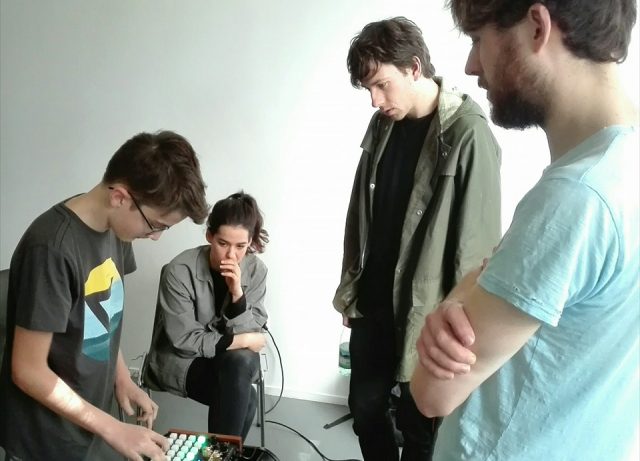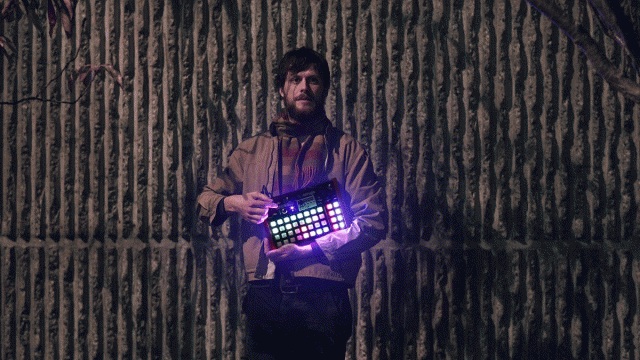
New Zealand based Synthstrom Audible has announced the Deluge – a new instrument that’s a portable sequencer, synthesizer and sampler.
The Deluge, developed by Synthstrom’s Rohan Hill, features 128 RGB pads, arranged in a 16 x 8 grid; a built-in synthesizer; up to 12 minutes of sample playback from SD card; and sequencing of up to thousands of notes.
10 pre-production units have been sold and tested with artists in New Zealand, and Hill has incorporated feedback into the final design, which will be available to order starting Oct 25th.
Here’s Hill with a Deluge pre-production prototype:

Synthstrom notes that images of the expanded production model, along with video demos, are expected to be available later this month.
Features:
- Piano-roll-style sequencing on 128 full RGB pads (16×8) with scrolling and zooming.
- Internal synthesizer engine (subtractive and FM).
- Plays samples from SD card (up to 32GB SDHC).
- Sequencing, limited only by available RAM (many thousands of notes).
- Polyphony limited only by CPU. Typically around 48 synth voices or 64 unaffected sample voices may play.
- 64MB of sample ram – work with up to 12 minutes (if mono) of CD-quality samples at once.
- Live adjustment of synth and effect parameters with two endless-turn encoders with LED level-meters. Easy buttons to select the functions these control.
- Advanced syncing capabilities. Weird time signatures supported. Adjustable swing.
- Dedicated volume and tempo knobs.
- LFOs and envelopes on each synth / sample. Highly customizable patching matrix.
- Synthesizer engine features LPF / HPF, arpeggiator, portamento, oscillator sync, ring modulation, unison detune, and more. Four basic waveforms, or select any WAV file from the SD card.
- FX including delay, reverb, chorus, flanger, phaser, bitcrushing, sidechain effect, live stutter, and more.
- Keyboard mode, where the pads become a live instrument on a 2D grid.
- Internal speaker, rechargeable Li-ion battery, and microphone
- Mic and line inputs.
- Two ¼” line outputs, and 3.5mm headphone output.
- 2x CV outputs. 0 – 10V, individually configurable to 1, 1.2, 0.26 or 0.32 volts per octave, or to hertz per volt.
- 4x gate / trigger outputs individually configurable to v-trig or s-trig, with shared voltage switchable between 5V and 12V. Trigger clock output configurable, up to 192 PPQN.
- Trigger clock input, also with adjustable PPQN.
- MIDI input and output via hardware connectors or USB.
- Powered via USB or 9 – 12V centre-negative (pedal-style) power supply (500mA) (not included).
- User-upgradeable firmware
- Dimensions: 305mm x 208mm x 46mm (12 x 8.2 x 1.8 inches).
Pricing and Availability
Synthstrom Audible says that the Deluge will be available worldwide later this year, with pre-orders starting October 25th. Pricing is still to be announced. To follow the development, see their Facebook page.
The Deluge will make its public debut at A-Synth Fest in St. Gallen, Switzerland on October 1, 2016.
Synthstrom says that private demos may also be possible in Europe, starting September 20th in Berlin, Hamburg, Cologne, Amsterdam, Eindhoven, Lille, Paris, Dijon, Zurich, St. Gallen, Munich or Prague. If you live in one of these cities and are interested in checking it out, contact Ian Jorgensen (at ian at synthstrom.com).

a youtube demo would be cool
yes, waiting for the videos. This thing has my attention. it’s gonna be about the pricing.
I checked with them about this and, as noted in the article, they said that images of the production model and video demos are expected to be available later this month.
I would buy one immediately if it had 8 audio outs . That’s what a lot of us need need in a sampler .
Yeah I don’t get modern ‘samplers’ with only stereo out. We need true modern MPCs. Otherwise I’ll stick with Maschine and an audio interface.
srsly though an animated gif?
atleast show us a full pic of the thing if not a yt demo.
srsly though, you forgot to read the article:
“Synthstrom notes that images of the expanded production model, along with video demos, are expected to be available later this month.”
Looking forward to seeing this in action.
Seems like it will be like Novation’s Circuit on steroids. Interesting…looking forward to seeing more in the months to come. Once it officially hits market…it still has to prove itself.
Okay so the thing he’s holding looks about the size of the listed dimensions, but it’s only got 40 pads. The real one must have way smaller pads to get 128 of them into the approximate space of a sheet of Letter/A4 paper.
No, the finished product will be bigger. I’ve tried it out and the pads stay the same size, but the machine just gets bigger.
If they’re making an improved boutique electribe then they might’ve thrown in more than just one stereo output. Come on! That’s one of the most requested features all the time!
16×8 grid? I see a 4×10 grid…
The version that he is holding is a demo, and the finished product will be bigger.
The limited # of outputs is a bit of a bummer but I’d still love to try it out. I’m a groovebox whore so I’ll try any of them at least once.
I’m interested to see what type of real-time sequencing options it supports. I’m still looking for the perfect live hardware sequencer that can act like a looper with variable length tracks (e.g., 1 bar for kicks, 2 for hi-hats/snare, 4 for bass line, 8 for pads, etc).
I almost have it with my old E-MU Command Station and from what I’ve read maybe the Octatrack can do it. The various Korg/Roland groove production boxes are too focused on 16-step patterns.
Maybe this will come in with the right features/price…
i discovered that a QUASIMIDI SIRIUS can do exactly that.
plus it has a great arpeggiator, a sound randomizer, a vocoder with different kinds of vocoding,
a filterbank where you can route sounds through and the overall sound is digital and “ravey”
but (not just) the basses can be amazing, especially when routed through the filterbank.
And it also can be really dark and spooky and mean
Quite amazing board…
Thanks for the pointer. Skimming the manual, that looks like an interesting instrument.
Can you build things in real-time – that is, without having to press stop when you switch to a new track/pattern/motif?
I’ve tried this machine (I’m actually the kid in the top photo), and it does support completely what you want to do. You can change the bar length of the loop, and the price is cheaper than any Octotrack I can tell you that.
I read that it plays samples from card, but can’t tell if it live samples via input? if not I don’t really think it’s a sampler?
Can’t imagine the mic/line inputs are just for passing through fx
No pics no interest… Learn!
I was actually hoping for something like this from Roland.. Got me interested.. Videos pls.
Looks cool on paper. It will come down to price, and if the UI is intuitive and spontaneous enough to give advantage over similar products. Honestly, I already want one!
wow 64 megs of ram… just like the 1997 asr-x pro… seriously guys… RAM IS CHEAP
That holds 12 minutes of audio – how many minutes of samples do you think you need for beat making?
Maybe you should explain what you want to do with groove box and how much sample time you think you need. You might have a workflow that you want to do that manufactures are not taking into consideration
Why no one in this world can make a modern hardware sampler groovebox with at least 1gb of RAM??!!! Come on, 64mb is less than that in an old MPC! It’s 21st century and ram is cheap as chips…
That’s what the Octatrack has, and people are able to live with it. If they’ve managed to optimise SD card reading (which is a big if) to stream efficiently, RAM size isn’t an issue.
Think about this, do you really need more than 12 minutes playback off an SD card? It doesn’t affect the performance (I’ve tried it)